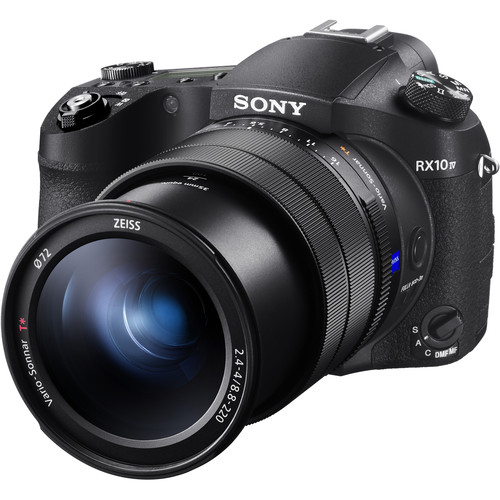Sony RX10 IV

Bird photography is a challenging yet rewarding pursuit for nature enthusiasts and photographers alike. To capture the fleeting moments of avian grace and beauty, you need a camera that combines portability, versatility, and exceptional image quality. Enter the Sony RX10 IV, a bridge camera that excels in various photographic genres, including bird photography. In this article, we will explore the features and advantages of the Sony RX10 IV for bird photography and provide valuable tips to help you make the most of this incredible tool.
The Sony RX10 IV: A Versatile Birding Companion
1. Impressive Zoom Range
One of the standout features of the Sony RX10 IV is its impressive zoom range. With a 24-600mm equivalent f/2.4-4 Zeiss Vario-Sonnar T* zoom lens, this camera allows you to capture birds in flight or perched high in trees with remarkable clarity and detail. The flexibility of the zoom range means you can capture close-ups of distant subjects without disturbing them, a critical factor in bird photography.
2. Lightning-Fast Autofocus
Birds are notoriously fast and unpredictable subjects, making autofocus speed crucial. The RX10 IV boasts an incredibly fast and accurate hybrid autofocus system that combines phase-detection and contrast-detection, ensuring that your feathered subjects are in sharp focus even during rapid movement.
3. High-Speed Continuous Shooting
To capture those fleeting moments when a bird takes flight or lands on a branch, you need a camera that can shoot at high speeds. The Sony RX10 IV can capture up to 24 frames per second in continuous shooting mode, ensuring you never miss a critical moment.
4. Exceptional Image Quality
With a 1-inch 20.1-megapixel Exmor RS CMOS sensor and a BIONZ X image processor, the RX10 IV delivers stunning image quality, even in challenging lighting conditions. The camera’s high dynamic range (HDR) capabilities help you retain detail in both shadow and highlight areas, ensuring your bird photographs are vibrant and full of life.
Tips for Successful Bird Photography with the Sony RX10 IV
Now that we’ve covered the camera’s features, let’s delve into some practical tips to help you make the most of your bird photography with the Sony RX10 IV:
1. Understand Bird Behavior
Before setting out to capture bird photographs, familiarize yourself with the behavior of the species you intend to photograph. Knowing their habits, feeding patterns, and preferred locations will increase your chances of finding and photographing them.
2. Patience is Key
Bird photography often requires long hours of waiting for the perfect shot. Be prepared to spend time observing and waiting for the right moment. Remember that patience can be rewarded with extraordinary photographs.
3. Use the Right Settings
Experiment with different camera settings to find what works best for your bird photography. Start with aperture priority mode to control depth of field and set your ISO to keep noise to a minimum. Adjust your shutter speed to freeze motion or capture motion blur, depending on the effect you want.
4. Utilize the Zoom Range
The RX10 IV’s versatile zoom lens allows you to capture birds in various situations. Use the wide end for landscape shots with birds in their natural habitat and zoom in to fill the frame when capturing detailed portraits.
5. Master Autofocus
Learn to use the camera’s autofocus modes effectively. Single-point autofocus is ideal for capturing stationary birds, while continuous autofocus is essential for birds in flight. Experiment with tracking modes to keep your subjects sharp as they move.
6. Compose Thoughtfully
Pay attention to composition in your bird photographs. Use the rule of thirds, leading lines, and negative space to create visually appealing images. Don’t forget to consider the background, as a cluttered or distracting background can detract from your subject.
7. Practice and Learn
Bird photography is an art that requires practice and continual learning. Study the work of renowned bird photographers, join photography forums or local birding groups, and, most importantly, keep experimenting and refining your skills.
Conclusion
The Sony RX10 IV is a remarkable tool for bird photography, offering a winning combination of zoom range, autofocus speed, continuous shooting capabilities, and exceptional image quality. By understanding bird behavior, exercising patience, and mastering the camera’s settings and features, you can elevate your bird photography to new heights and capture the exquisite beauty of our feathered friends with the utmost precision and clarity.
We are affiliated with Amazon and make a small royalty at no extra cost to you, so by using the links below to purchase your next birding gear you can help us to maintain Simply Birding and continue to bring great content:

Canon, Sony and Nikon cameras: https://amzn.to/4gmtDWk

Lenses for bird photography: https://amzn.to/3WG3vyF

Tripods: https://amzn.to/3PVDNT0

Memory Cards: https://amzn.to/3PV4Y0z

Bird books: https://amzn.to/42NgsKS

Binoculars for bird watching: https://amzn.to/42G0nGZ

Spotting Scopes for bird watching: https://amzn.to/4hom5nq















